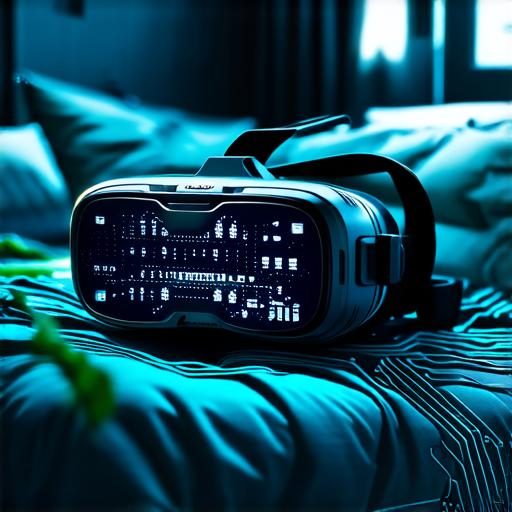Introduction:
Virtual reality (VR) is an emerging technology that has gained immense popularity in recent years. It’s an immersive experience that simulates a 3D environment, allowing users to interact with virtual objects and environments as if they were real.
Benefits of Virtual Reality App Development:
Virtual reality app development has numerous advantages that make it an attractive option for businesses and developers alike. One of the main benefits is the ability to create highly engaging and interactive experiences for users. VR apps can transport users into immersive environments, allowing them to explore new products, services, or ideas in a unique way.
Another benefit of virtual reality app development is the potential for increased user engagement and retention. VR apps can provide users with personalized experiences that are tailored to their preferences and interests. This can lead to higher levels of user engagement and increased retention rates, as users are more likely to return to an app that provides them with a memorable and enjoyable experience.
Virtual reality app development also has the potential to improve user experience (UX) by allowing businesses to create more realistic and intuitive interfaces. By simulating real-world environments, VR apps can provide users with a sense of presence and immersion that is not possible with traditional 2D interfaces. This can lead to improved usability, reduced frustration levels, and increased user satisfaction.
Challenges of Virtual Reality App Development:
While virtual reality app development offers numerous benefits, it also presents several challenges that must be overcome. One of the main challenges is the high cost of development. VR apps require specialized skills and technologies, which can make them more expensive to develop than traditional 2D apps.
Another challenge of virtual reality app development is the need for powerful hardware. VR apps require high-performance computers or gaming consoles, which can be expensive and may not be accessible to all users. This can limit the potential reach of VR apps and make them less attractive to businesses that want to reach a wider audience.
Virtual reality app development also requires careful consideration of user experience (UX) design. VR apps must be designed with the user in mind, taking into account their physical and psychological needs in order to create an immersive and enjoyable experience. This can be challenging, as designers must balance realism with usability and safety concerns.

Best Practices for Virtual Reality App Development:
To overcome the challenges of virtual reality app development, it’s important to follow best practices that ensure high-quality app development and user experience. One of the main best practices is to conduct thorough research and planning before starting development. This includes identifying the target audience, defining the app’s goals and objectives, and determining the most suitable VR platform and hardware requirements.
Another best practice for virtual reality app development is to prioritize user experience (UX) design. This includes designing intuitive interfaces that are easy to navigate, creating realistic and immersive environments, and ensuring the safety and well-being of users. It’s also important to conduct user testing and gather feedback to make improvements to the app over time.
Virtual reality app development also requires careful consideration of performance optimization. VR apps must be optimized for high-performance hardware and must minimize lag and motion sickness in order to provide a seamless and enjoyable experience. This includes using advanced graphics and rendering techniques, minimizing the number of assets, and testing the app on different devices and platforms.
Case Studies:
To illustrate the benefits and challenges of virtual reality app development, it’s helpful to look at real-world case studies of successful VR apps. One such example is IKEA’s “Place” app, which allows users to virtually place furniture in their homes before purchasing it. The app uses augmented reality (AR) technology to provide a realistic and immersive experience that helps users make informed decisions about their purchases.
Another successful VR app is the “Star Wars: Galaxy’s Edge” VR experience at Disneyland. The app allows users to explore the Star Wars universe in a highly immersive and interactive way, providing them with a unique and memorable experience that enhances their overall visit to the theme park.
Virtual Reality App Development FAQs:
1. What is virtual reality app development?
Virtual reality app development involves creating apps that can be experienced in a 3D environment using VR devices such as headsets, smartphones, and gaming consoles.
2. What are the benefits of virtual reality app development?
Virtual reality app development offers numerous benefits, including increased engagement and retention, improved user experience (UX), and the ability to create highly interactive and immersive experiences for users.
3. What are the challenges of virtual reality app development?
The challenges of virtual reality app development include high cost, limited hardware accessibility, and the need for careful consideration of user experience (UX) design.
4. What are some best practices for virtual reality app development?
Best practices for virtual reality app development include thorough research and planning, prioritizing user experience (UX) design, and performance optimization to ensure seamless and enjoyable experiences for users.
5. Can you provide any examples of successful VR apps?
Yes, successful VR apps include IKEA’s “Place” app and the “Star Wars: Galaxy’s Edge” VR experience at Disneyland.
6. How can businesses benefit from virtual reality app development?
Businesses can benefit from virtual reality app development by creating engaging and immersive experiences for users, improving user experience (UX), and increasing user engagement and retention rates.



